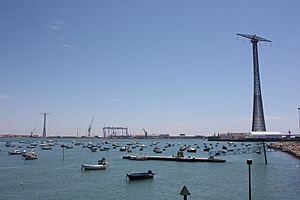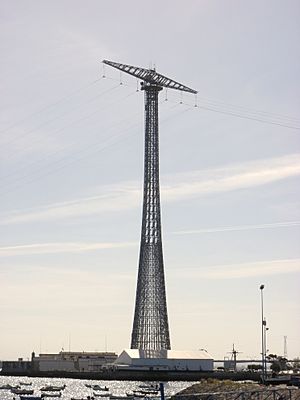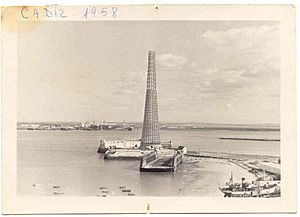Pylons of Cádiz facts for kids
The Pylons of Cádiz are two very tall towers that carry electricity cables over the Bay of Cádiz in Spain. They are also known as the Towers of Cádiz. These towers are 158 meters (about 518 feet) high. They help bring 132,000-volt AC power from a substation in Puerto Real to a substation in the city of Cádiz.
What Are the Pylons of Cádiz?
The Pylons of Cádiz are located near Fort Puntales and the Puntales Naval Station in Cádiz. Another part of the crossing is near the Matagorda area. The entire power line crossing has 16 towers in total. Two of these are the main, very tall suspension pylons, each 158 meters (518 feet) high. These two towers carry the power lines right over the wide Bay of Cádiz.
There are also two special concrete structures called "strainer portals." These portals help to hold the power lines tightly. From each strainer portal, there are six smaller, single-pole structures called "monopolar strainers." These connect the power lines from the portals to the first regular power line towers, or to the electrical station in Cádiz. The strainer portal at the southern end is close to the Cádiz Substation. The one at the northern end is in Matagorda. The rest of the power line uses standard pylons with three crossbars, which hold six electrical cables. Interestingly, this power line crossing does not use a special "ground conductor" cable in the main span, even though the towers are very tall.
How Were They Designed and Built?
Each of the main towers has a unique shape. It looks like a hollow cone with the top cut off, which is called a "frustum." The bottom of the tower is wider, about 20.7 meters (68 feet) across. It gets narrower towards the top, where it is only six meters (20 feet) wide. The towers stand on strong concrete bases. At the very top, each tower has a single crossbar shaped like a diamond. This crossbar holds the insulators that keep the electrical cables in place. Inside each tower, there is a spiral staircase that goes all the way to the top.
This unusual design was created by an Italian engineer named Alberto M. Toscano. It was chosen because, at that time, steel factories in Spain could not make the very large steel parts needed for more traditional towers. Also, it was difficult to import such parts into Spain during the time of Francoist Spain, when the country had strict rules about trade.
The building of these towers was managed by Remo Scalla, who was a close friend of Toscano. Toscano, the designer, and Scalla, the builder, also worked together on another famous project: the Pylons of Messina. Those pylons carry power lines across the Strait of Messina in Italy, connecting the mainland to the island of Sicily. The Cádiz project began in late 1957 and was finished in 1960. After they were built, the towers were bought by the Spanish National Institute of Industry.
See also
 In Spanish: Pilones de Cádiz para niños
In Spanish: Pilones de Cádiz para niños
- Costa de la Luz
- List of towers
- The Shukhov Tower on the Oka River in Russia has a similar design.




